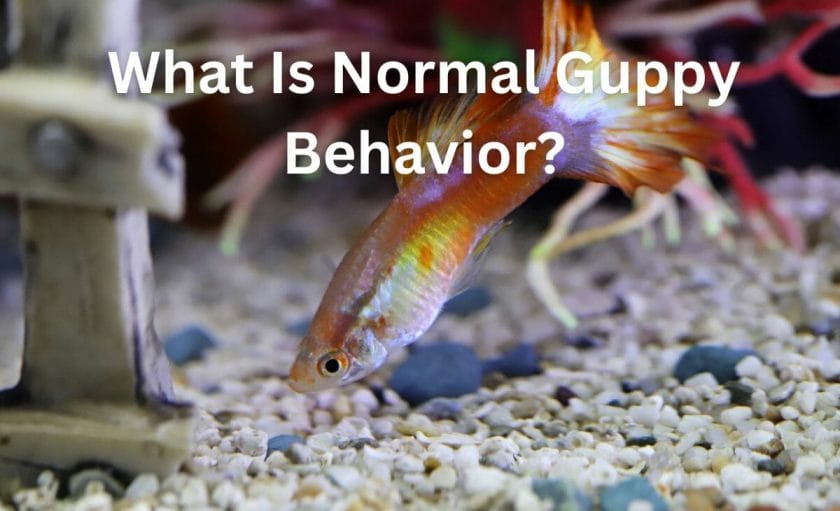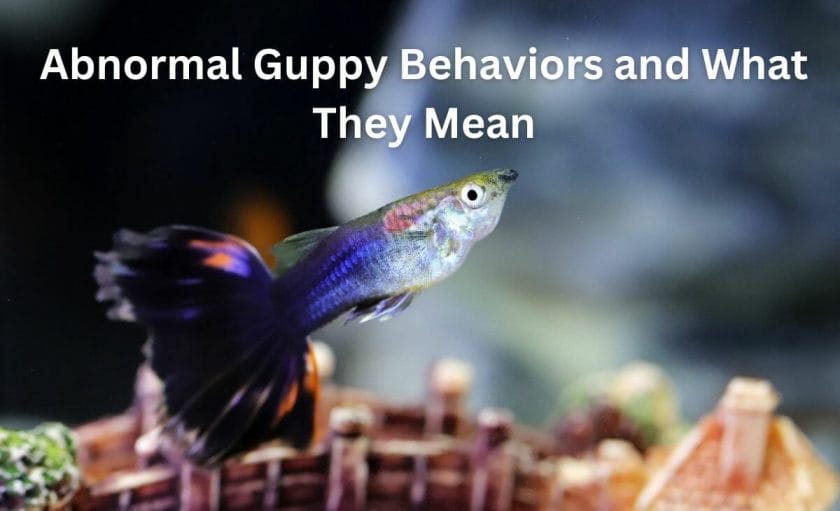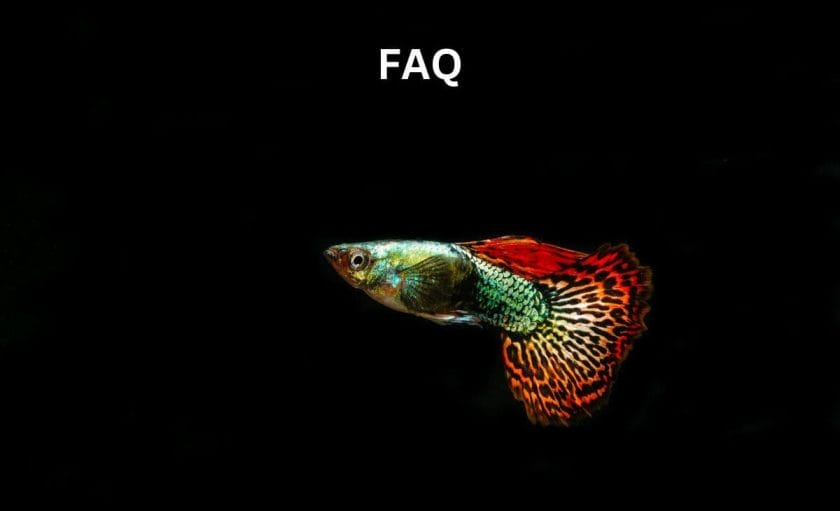Few fish have more widespread appeal than guppies. They’re small, colorful, and great for beginners; however, understanding their behavior is a good first step to helping your fish live a long and happy life.
Guppies have a peaceful temperament, but the males may fight with one another or harass the females. As such, it’s ideal to keep your guppies at a ratio of 1 male to 3 females.
While they are great beginner fish, you still need to take proactive steps to keep them healthy, and that starts by understanding their behavior.
Keep reading, because I’m going to share important guppy behavior characteristics, how they play out in a tank, and how you can detect changes in behavior early.

Table of Contents
What Is Normal Guppy Behavior?

Guppies are high-octane fish that are generally very active and may swim with other guppies. You will often see them swimming at the middle level of a tank, except at night when they may hide or be still while sleeping.
Group Swimming
Guppies shoal, which is not the same as schooling. Schooling fish huddle closely together to protect themselves from predators. Harlequin Rasboras are a good example; you will rarely find them apart from one another.
On the other hand, guppies may branch out a lot more and operate more independently. There’s nothing abnormal about this behavior.
Still, it’s important to remember that guppies need to be in groups of at least 4, 1 male to 3 females. A group of 6-8 guppies is ideal, which is why, despite their small size, aquarists recommend at least a 10-gallon tank.
High Activity
Guppies are very energetic fish, rarely motionless and constantly on the go. While their behavior may seem a little erratic at times, energetic behavior isn’t a sign of illness or injury, unless the swimming is erratic.
Guppies do sleep, however, so they may slow down and swim in place, usually under or near a hiding spot. Pregnant guppies may also appear lethargic when they are about to give birth.
Most fish appear active, but guppies may appear more so because of their long, flowy fins; these fins make it more challenging for the guppies to glide smoothly through the water, especially if the water current is strong. Ideally, keep the current low to accommodate these active fish.
Constant Breeding
Guppies breed prolifically, with the females livebearing fry every 4-6 weeks. Males spend most of their time chasing the females to breed, which is why a 1:3 ratio is perfect for guppy tanks. Males can also be a little nippier and will infight, as they will regularly quarrel over breeding rights.
Peaceful Temperament
Guppies have a very peaceful temperament and won’t pick fights with other fish. Their small size can make them a target for other, larger fish, so it’s important to carefully pick your tank mates.
They are rarely prone to aggression, unless it’s with other males in the tank. While they are peaceful, guppies will eat anything small enough to fit into their mouths, including their own fry; keep that in mind if you’re planning on breeding them.
Flaring
One common behavior you’ll see in a guppy tank is flaring. Males woo females with elaborate dances, which may include flaring their fins or spreading them. This behavior shows off their beautiful colors and is a perfectly natural part of guppy life.
In fact, it only serves to highlight the gorgeous colors and markings that the males display.
Regular Pregnancy
If you have a male and female in your tank, then it’s inevitable that the female will become pregnant over time.
Often, new guppy keepers will worry that the rotund abdomen is a sign of swim bladder disease.
Pregnant females have what’s called a gravid spot, a dark speck near the anal fin. This is not an indication of a bacterial infection or parasite. These conditions are a normal part of pregnancy and a typical part of guppy behavior.
Guppies are livebearers, meaning that the fry emerge fully developed and are birthed into the tank where, without external protection, the majority will be consumed by any of the fish in your tank.
Occasional Glass Swimming
Many fish ‘surf’ against the glass, but doing so isn’t necessarily a sign that something’s wrong with the tank environment. Guppies may swim against the glass if they have been recently introduced to the environment and are curious about their surroundings. If that’s the case, then the behavior should stop over time.
They may also be attracted to their reflection or simply follow you around, especially if they learn to associate you with food.
In some cases, glass surfing is a sign of stress, in which case, you need to consider the size and water parameters of your tank. Usually, surfing means that your tank is too small. I recommend at least a 10-gallon tank for guppies, although a 20 might be better if you have a community tank.
Abnormal Guppy Behaviors and What They Mean

By understanding the difference between normal and abnormal behaviors, you can often detect illnesses, parasites, and infections earlier, giving you the edge on treatment.
What Does Erratic Swimming Mean?
Guppies are constantly on the go, but if their swimming seems jerky or sudden, it may be a sign of stress or poor water conditions.
Being Startled
Fish are easily startled, so if you see your guppies darting infrequently, it’s likely nothing to worry about. If the behavior is common for all of your guppies, they may be highly stressed, or the tank conditions may be poor.
I recommend investing in an aquarium test kit so that you can monitor your water parameters and keep them in check.
Disorientation or Upside-Down Swimming
Guppies swimming on their side or upside down may be disoriented or ill, again potentially due to poor water quality. They may also have swim bladder disease, common in guppies. The swim bladder is a gas-filled organ that aids in swimming; when it functions improperly, guppies may swim nose down or entirely upside down.
Swim bladder disease can be difficult to diagnose and difficult to treat or manage. Guppies, like all fish, are prone to overindulging on food, so if all of your guppies are ‘beached’ on the substrate or seem a little floatier, it’s usually only temporary; just feed less next time.
Parasites
Similarly, guppies may ‘flash’ on rocks or other hardscaping elements to try to rid themselves of parasites.
Be mindful of ich, a common guppy killer. If you see your guppies dashing themselves against your decorations, this parasite is a likely cause.
Ich has a very fast lifecycle and can quickly wipe out a tank if left untreated. One of your first signs of this parasite (or other external parasites) is ‘flashing,’ wherein guppies or other fish will scrape themselves against something hard, like your decorations or substrate, in an attempt to remove the parasites.
These measures are ineffective, but they can be an early warning sign that your fish are in distress. Look for sudden, quick movements that stir up the substrate. Dashing against something can distinguish this erratic behavior from that associated with poor water quality.
Still, many parasites are invited into a tank by poor water quality, so it’s probably still a good idea to run some tests and make changes, if only to prevent future tank issues.
What Does Lethargy Mean?
Guppies who aren’t regularly active may be experiencing stress or low oxygen, especially if the lethargy is accompanied by difficulty breathing. You’ll notice your guppies ‘heaving’ if they are having trouble breathing.
Stress is a common cause of lethargy, usually due to an unsuitable environment. First, make sure your tank is the right size and shows no recognizable signs of parasitic or bacterial infection; either can make your fish stressed due to the increased strain on their immune system.
More likely, your pH, temperature, or other water parameter is out of alignment.
For reference, here’s a handy chart you can reference to know what basic parameters are ideal for guppies:
| pH | 6.0-8.0 |
| Temperature | 72-82 F (22-28 C) |
| Water Hardness | 5-15 dGH |
It’s important to recognize that sudden changes in water parameters can cause stress. Just as with humans, temperature shock is extremely harmful and stressful to guppies.
What Does Fin Clamping Mean?
Guppies may clamp their fins, drawing them in close to their body if they are ill or feel threatened.
Stress
Usually, fin clamping is a response to bullying. In a tank with an improper ratio of males to females, females may be harassed to the point of being very stressed. To combat this, make sure you stick to the 1:3 male-to-female ratio and provide plenty of places for your females to hide.
That could include plants, hardscaping elements, or tall grass. Tall grass is especially beneficial to provide your females with a safe place to breed and fry to hide if you’re trying to encourage your tank population to grow.
Aggression may be more prevalent in tanks that are too small. Even peaceful fish can become aggressive when real estate is at a premium, so it’s always important to consider your long-term goals. What fish do you want to keep? What tank size do they realistically need?
Getting multiple smaller tanks or a singular larger tank are both options to spread out aggression, but most importantly, you should choose your tank mates carefully.
Here are some good options to consider:
- Tetras
- Rasboras
- Rainbowfish
- Corydoras catfish
- Shrimp
- Siamese algae eater
Bottom feeders are usually a good option, as are peaceful dither fish. By contrast, here are some tankmates you should avoid:
- Barbs
- Oscars
- Cichlids
- Goldfish
- Kilifish
Water Parameters
Poor water quality or infections can also cause clamped fins, which is a stress response to unideal conditions. In particular, you should check your ammonia levels when you see fin clamping, as it’s the most common cause.
Ammonia is a toxic compound that builds up as fish produce waste. If the bacteria living in your filter aren’t equipped to deal with it, either because your tank isn’t properly cycled or your filter isn’t powerful enough, ammonia will spike, leading to a range of harmful conditions in your tank.
It’s important to make sure your tank is properly cycled before introducing fish and that you do not overfeed your tank. Excess food is the most common cause of ammonia spikes. If there’s leftover food 30-60 minutes after you feed a tank, reduce the amount or frequency of your feedings.
You can use a test kit to monitor ammonia, nitrites, and nitrates to see whether your nitrogen cycle is established. A cycled tank should read 0 ppm ammonia, 0 ppm nitrites, and under 40 ppm nitrates.
FAQ

Can Guppies Live with Betta Fish?
Betta temperaments vary greatly, but in most cases, guppies can coexist with betta fish. Just be sure that the tank is big enough to host the two species and that the guppies have places to rest, such as behind plants or decorations.
Do Guppies Eat Their Babies?
Yes, guppies will eat their fry given the chance, even if they are the direct parents. Guppy fry are a small and easy meal for adult guppies, as well as for most other types of fish, so if you want to keep fry, you will need to set up a fry tank.
Do Guppies Need a Filter?
Yes, guppies need a filter to survive; otherwise, ammonia will build up until the fish are killed. The beneficial bacteria that power the nitrogen cycle help convert ammonia into less toxic compounds, and a filter is essential to that process.
Conclusion
Guppies have a peaceful temperament and boundless energy, a great combination for peaceful community tanks or even guppy-only tanks.
If you’re thinking about keeping them, be sure to understand their typical behavior; that way, you can preempt and address signs of abnormal behavior before the underlying cause becomes untreatable.
Make sure to review the helpful information above to understand how guppies typically act and whether they’re right for you!